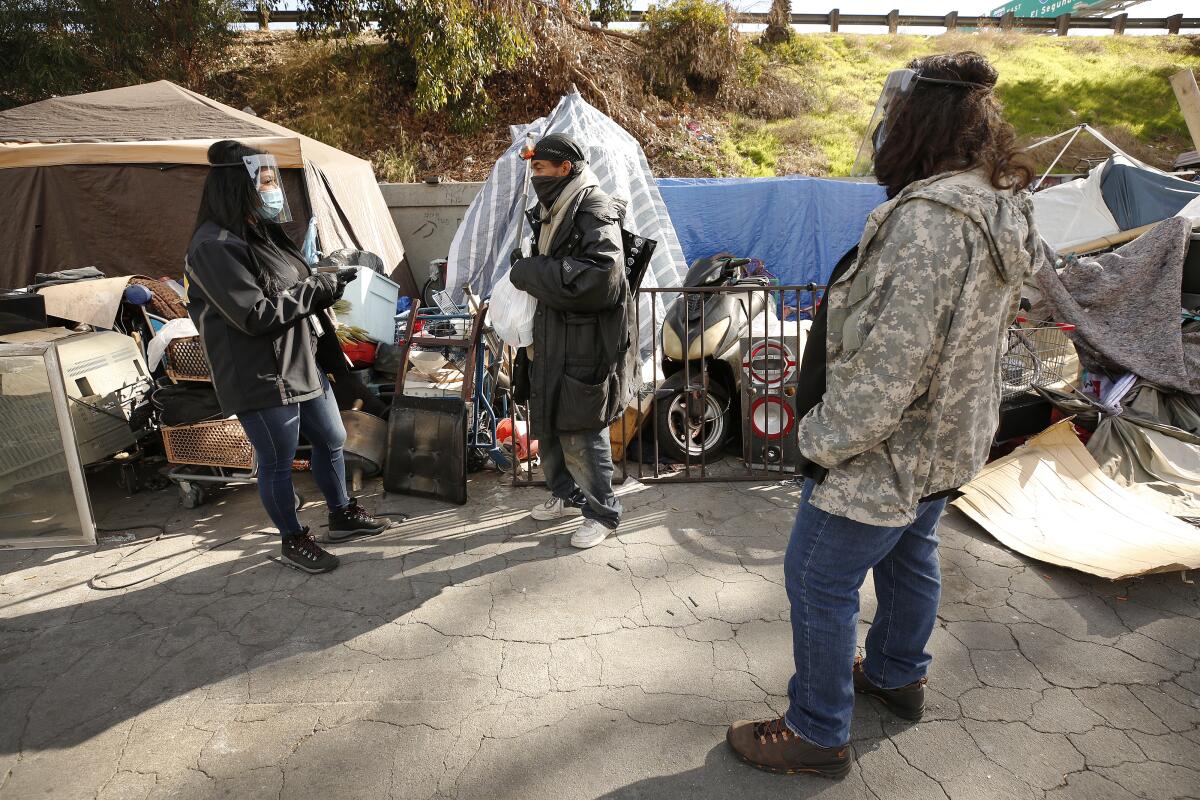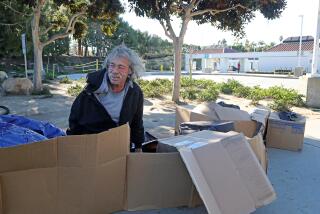Editorial: No homeless people should be shooed off a sidewalk before they are offered housing

When the city of Los Angeles passed a sweeping anti-camping ordinance this summer, the goal was to clear sidewalks of homeless encampments ballooning across the city. But City Council members also vowed to put in place an official street engagement strategy laying out how the city will reach out to people on sidewalks with offers of shelter or other temporary housing before they are shooed off a sidewalk or, worse, cited by police.
Implementing the street engagement strategy should be a predicate to any enforcement, as Councilman Mark Ridley-Thomas, one of the main supporters of an outreach approach, has said repeatedly.
Well, guess what? The anti-camping ordinance takes effect Friday, but the street engagement strategy governing outreach has yet to make its way to the full City Council for a vote. It was forced to slog through two council committees, passing unanimously out of the second on Thursday.
The exasperating thing is that the strategy should have gone into effect the same time as the ordinance. Now, it needs to be brought before the full council swiftly for adoption. And until then, the city should not enforce the ordinance except to keep clear the most essential pathways â driveways, entrances, and the sidewalks around fire hydrants.
Thereâs no question that this is the more challenging part of the plan to move homeless people off sidewalks. The strategy, which got a thoughtful hearing from the Energy, Climate Change, Environmental Justice and River Committee, is an elaborate process involving numerous teams of outreach workers and steps to be followed before sanitation workers ever show up to clean a sidewalk.
Thatâs fine. The council can tinker with the details and the time frame. As Councilman Paul Krekorian said Thursday during the committee meeting, âWe are probably going to be back here revising this strategy many, many timesâŚ. It should be a work in progress.â
The key thing: This strategy doesnât work unless there is temporary housing followed by permanent housing for people, as Ridley-Thomas noted. And if it takes several weeks or several months to house all the people living in an encampment, thatâs OK as well. No matter how much residents are itching to have a neighborhood encampment disappear, enforcement alone means people simply shuffle from a forbidden sidewalk to one that has yet to be declared off-limits. They must be offered reasonable housing options. Of course that sometimes involves a good outreach worker coaxing an individual to give a housing placement a try. But that takes time as well.
And Los Angeles Police Department officials are not looking to be the primary enforcers of this new ordinance. In fact, they hope it doesnât get to the point of citations and arrests. We hope it doesnât either. Asked about it during a meeting with The Times editorial board, Chief Michel Moore said, âThe Police Department should be the last ones in. And then weâre going to lead with a seeking of voluntary compliance.â
Moore said heâs hoping that âthe street engagement teams are going to be effective ... theyâre going to have proper resources for housing and supportive services, and that the issues of having to get to an enforcement position will be minimal.â
Under the anti-camping law, council members must formally propose sites they want cleared. The ordinance allows areas near schools, parks and recently set-up housing or shelter for homeless people to be designated as camping-free zones. Council members can also propose specific areas in their districts where they believe encampments are a problem. (They have to offer documentation of that.) But the whole council needs to agree before certain areas are declared off-limits to camping.
Council member and mayoral candidate Joe Buscaino proposed 11 sites in his district even before the law went into effect. They are all near homeless shelters and temporary housing. They are currently clear of encampments, and Buscaino wants them to stay that way. Heâs also proposed that 1,000 public school sites be designated camping-free zones.
Buscaino wonât be the only council member eager to declare no-camping sites in a council district. And thatâs all the more reason the city must have a street engagement strategy in place before it allows any enforcement.
More to Read
A cure for the common opinion
Get thought-provoking perspectives with our weekly newsletter.
You may occasionally receive promotional content from the Los Angeles Times.










